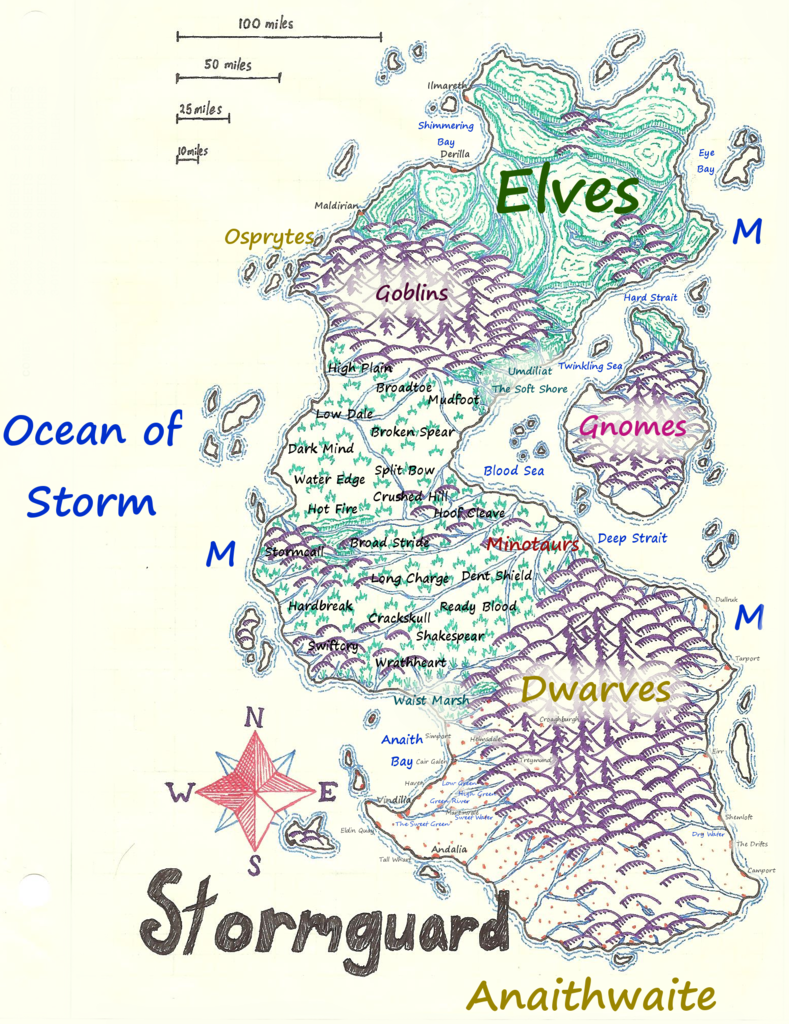Post by rorrik on Jul 18, 2015 5:02:46 GMT
I really took this article about travel distances and nation sizes to heart, and it shows in the setting for my current most frequent campaign, an island about the size of Great Britain:

Stormguard was first populated by orcs, who somehow found their way into much of the world ahead of everyone else. The southern tip, which the orcs had mostly left alone, was later settled by halflings who had been blown their in primitive, almond-like vessels at the whim of the wind goddess, Anaith.
Shortly thereafter, the main body of the elves banished from their lands a large portion of the population in a bloody war. This included most of those favored with magic, because magic was seen as full of darkness and evil. Many of the elves so banished were indeed of dark heart and remained underground, becoming the Drow and rapidly expanding, conquering the Dwarves in the are and eventually reaching Stormguard by undersea tunnels before being held at bay by the Livecaps. But some of the banished elves were not evil at heart, merely enthralled with the pursuit of magic. These accepted their banishment better and found the undersea tunnels ahead of the Drow, traveling to Stormguard where they befriended many of the orc tribes and eventually settled in the Northern woods, teaching their descendants, as the orcs did, that Stormguard was the origin of their race.
Seeing the downfall of the dwarves before the drow and how they sacrificed themselves to seal their caves, the gnomes of the mainland ceased their deep delving and began to grow on the surface, but to the South were humans and orcs and minotaurs with which they did not want to have relations. Seeking for new land to settle, they became master ship builders, sailing out in search of ore filled mountains to build settlements, preferably on lonely islands. One of the locations they favored with a large settlement was the isle of Lesser Stormguard, where they built a thriving mining community without much fear of the Drow.
It was sometime before new people arrived in Stormguard after that, though some records claim that the Osprytes were blown there during this period of stability. Indeed, the next arrivals did little to change the relations on the island. Dwarves, escaped after generations of slavery, emerged in the Southern mountains. The Livecaps aided their escape and gave them caverns near the surface to work in as they began to rebuild what oral tradition assured them was their culture and heritage. They hardly bothered to surface in the new lands, going straight to mining, smithing, and working the stone of their caverns into majestic halls.
The next change seemed minor at the time, but it set in motion changes that would rock the island to the current day. The gnomes of the mainland formed an alliance with the growing nation of Vardor, whose founder was now a god, and as a gesture of goodwill, released all human and minotaur slaves in their possession who did not desire to stay and work for wages. Most of the slaves in Lesser Stormguard opted to leave, spending their release stipend on boats. The minotaurs sailed West, settling in orc lands with only a little conflict. At first the orcs saw them as another tribe, and their land grab was seen as a display of power and applauded by nearby tribes. The humans landed to the South, in a rocky, uninhabited land where the hills rolled right down to the sea. They had some conflict with dwarves who scouted the surface there and the dwarves became still more isolationist.
Meanwhile, Craithe, the god of the wilds, worshipped by the orcs with great fervor, became enraged at all of the varied peoples encroaching on his sacred wilderness. The elves had tamed the forest to the North, the Halflings farmed the lands to the South, and now Minotaurs had arrived capturing and leaving unused some of his shrines and altars. He commanded his priests to preach multiplication to the orcs and soon their populations were booming. They needed more land to maintain their hunter-gatherer lifestyle. The minotuars rebuffed any attempts to reclaim that land, and the elves retaliated quickly with powerful armies and magics to any incursions into their lands. The South was all that remained. The orcs of the South descended upon the Halflings, taking much of their land and pressing on through the storms of winter to push the smaller foes back toward the sea from which they had emerged.
Anaith loved the Halflings, but there was little she could do to help them, with the orcs ignoring her storms. But then fortune struck. A small flotilla of Vardor ships was passing out into the deep ocean, going behind many other such expeditions that had never returned. These courageous men could surely save her Halflings. She blew the small fleet on a wind that threatened to sink the small, coastal ships until they found shelter in what would be called Anaith Bay. The expedition did not have many warriors, but they were fierce and when confronted with the warring orcs, they fought valiantly and with faith that their god, Vardor, supported their fight. Their fight became a brief reprieve for the Halflings as orc returned from the war with them to protect territory rapidly being claimed by the Vardor knights. Soon, reinforcements were able to arrive and the Halflings were rescued, allowed to settle in the heart of Antaithwaite, the first colony of Vardor. The orcs were pushed back beyond the Waist Marsh and the border was fortified. The population boomed as intrepid settles arrived from Vardor, and though the orcs resented their losses, there was little they could do.

Stormguard was first populated by orcs, who somehow found their way into much of the world ahead of everyone else. The southern tip, which the orcs had mostly left alone, was later settled by halflings who had been blown their in primitive, almond-like vessels at the whim of the wind goddess, Anaith.
Shortly thereafter, the main body of the elves banished from their lands a large portion of the population in a bloody war. This included most of those favored with magic, because magic was seen as full of darkness and evil. Many of the elves so banished were indeed of dark heart and remained underground, becoming the Drow and rapidly expanding, conquering the Dwarves in the are and eventually reaching Stormguard by undersea tunnels before being held at bay by the Livecaps. But some of the banished elves were not evil at heart, merely enthralled with the pursuit of magic. These accepted their banishment better and found the undersea tunnels ahead of the Drow, traveling to Stormguard where they befriended many of the orc tribes and eventually settled in the Northern woods, teaching their descendants, as the orcs did, that Stormguard was the origin of their race.
Seeing the downfall of the dwarves before the drow and how they sacrificed themselves to seal their caves, the gnomes of the mainland ceased their deep delving and began to grow on the surface, but to the South were humans and orcs and minotaurs with which they did not want to have relations. Seeking for new land to settle, they became master ship builders, sailing out in search of ore filled mountains to build settlements, preferably on lonely islands. One of the locations they favored with a large settlement was the isle of Lesser Stormguard, where they built a thriving mining community without much fear of the Drow.
It was sometime before new people arrived in Stormguard after that, though some records claim that the Osprytes were blown there during this period of stability. Indeed, the next arrivals did little to change the relations on the island. Dwarves, escaped after generations of slavery, emerged in the Southern mountains. The Livecaps aided their escape and gave them caverns near the surface to work in as they began to rebuild what oral tradition assured them was their culture and heritage. They hardly bothered to surface in the new lands, going straight to mining, smithing, and working the stone of their caverns into majestic halls.
The next change seemed minor at the time, but it set in motion changes that would rock the island to the current day. The gnomes of the mainland formed an alliance with the growing nation of Vardor, whose founder was now a god, and as a gesture of goodwill, released all human and minotaur slaves in their possession who did not desire to stay and work for wages. Most of the slaves in Lesser Stormguard opted to leave, spending their release stipend on boats. The minotaurs sailed West, settling in orc lands with only a little conflict. At first the orcs saw them as another tribe, and their land grab was seen as a display of power and applauded by nearby tribes. The humans landed to the South, in a rocky, uninhabited land where the hills rolled right down to the sea. They had some conflict with dwarves who scouted the surface there and the dwarves became still more isolationist.
Meanwhile, Craithe, the god of the wilds, worshipped by the orcs with great fervor, became enraged at all of the varied peoples encroaching on his sacred wilderness. The elves had tamed the forest to the North, the Halflings farmed the lands to the South, and now Minotaurs had arrived capturing and leaving unused some of his shrines and altars. He commanded his priests to preach multiplication to the orcs and soon their populations were booming. They needed more land to maintain their hunter-gatherer lifestyle. The minotuars rebuffed any attempts to reclaim that land, and the elves retaliated quickly with powerful armies and magics to any incursions into their lands. The South was all that remained. The orcs of the South descended upon the Halflings, taking much of their land and pressing on through the storms of winter to push the smaller foes back toward the sea from which they had emerged.
Anaith loved the Halflings, but there was little she could do to help them, with the orcs ignoring her storms. But then fortune struck. A small flotilla of Vardor ships was passing out into the deep ocean, going behind many other such expeditions that had never returned. These courageous men could surely save her Halflings. She blew the small fleet on a wind that threatened to sink the small, coastal ships until they found shelter in what would be called Anaith Bay. The expedition did not have many warriors, but they were fierce and when confronted with the warring orcs, they fought valiantly and with faith that their god, Vardor, supported their fight. Their fight became a brief reprieve for the Halflings as orc returned from the war with them to protect territory rapidly being claimed by the Vardor knights. Soon, reinforcements were able to arrive and the Halflings were rescued, allowed to settle in the heart of Antaithwaite, the first colony of Vardor. The orcs were pushed back beyond the Waist Marsh and the border was fortified. The population boomed as intrepid settles arrived from Vardor, and though the orcs resented their losses, there was little they could do.






 . My gnomes are kind of solitary viking types, or they would be if they hadn't decided they liked most of their neighbors well enough not to enslave them anymore.
. My gnomes are kind of solitary viking types, or they would be if they hadn't decided they liked most of their neighbors well enough not to enslave them anymore.

